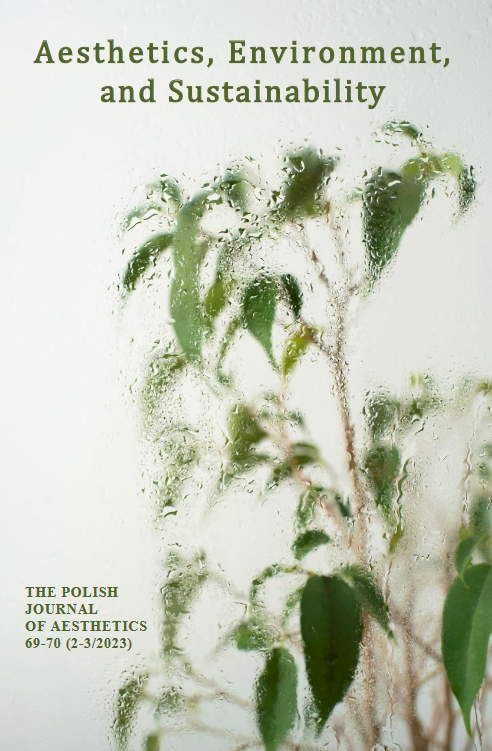Numer 69-70 (2-3/2023)
Aesthetics, Environment, and Sustainability|
Spis treści
Strony
Pobierz
|
|||||
|
|
|||||
|
INFORMACJE O AUTORACH Arto Haapala Helsingin yliopisto (Helsingfors universitet), Finlandia Virpi Kaukio Itä-Suomen yliopisto, Finlandia Noora-Helena Korpelainen Helsingin yliopisto (Helsingfors universitet), Finlandia Mateusz Salwa Uniwersytet Warszawski |
|||||
|
Stephanie Schuster
Aesthetic Deep Time Experiences of Temporal Sublime Nature
DOI: 10.19205/69-70.23.1
1 – 15
|
|||||
|
Słowa kluczowe Deep Time |Environmental Aesthetics |Temporal Sublimity |Aesthetic Resonance |AtmosphereStreszczenie Deep time, encompassing the expansive temporal scale of Earth’s and the universe’s history, bears the potential of alienation due to its immensity. However, this estrangement can be mitigated through aesthetic appreciation of the temporal sublime in nature, as found in geological landscapes, ancient forests, and the starry sky. This paper aims to elucidate aesthetic deep time experiences and their significance. It posits that aesthetic resonance with the awe-inspiring atmosphere of ancient and enduring natural environments fosters an elevating yet humble feeling of belonging and being at home in the vast temporal continuum of the natural world. Central to such aesthetic experiences is a felt integration of world time and life time. INFORMACJE O AUTORZE
Uniwersytet w Bazylei (Universität Basel), Szwajcaria
|
|||||
|
Elena Romagnoli
Situatedness in Landscape Sustainability. A Hermeneutical Approach
DOI: 10.19205/69-70.23.2
17 – 31
|
|||||
|
Słowa kluczowe hermeneutics |Sustainability |Situatedness |Landscape AestheticsStreszczenie In this paper, I claim that some hermeneutical concepts developed by Hans-Georg Gadamer might help us elaborate a philosophical understanding of landscape’s sustainability. In particular, the notion of “situatedness” as the intrinsic finitude of human beings located in a spatial-temporal context is conceived as a productive element by Gadamer. After having recalled the meaning of this notion in Gadamer’s thought, I will show how it can provide a valuable contribution, firstly, to the critique of an idea of sustainability as a mere “musealization” of exceptional places, whose counterpart is the exploitation of places considered aesthetically insignificant. Secondly, I will highlight the potentialities of situatedness for the formulation of an approach that takes into account, on the one hand, the relationality that characterizes the relationship between humans and landscape in a way that contrasts a dualistic conception, and, on the other hand, the radical historicity of every specific landscape as well as our approach to landscape that evolves throughout history. Against mere appropriation and, on the opposite, contemplation, the concept of situatedness may enable us to highlight an immersive and participatory approach to landscapes, recalling the responsibility towards the places that we inhabit and visit. |
|||||
|
Zoltán Somhegyi
The Changing Modes and Manifestations of Ruination. Nostalgia for Classical Decay
DOI: 10.19205/69-70.23.3
33 – 44
|
|||||
|
Słowa kluczowe Nostalgia |Sustainability |Heritage |Ruins |RuinationStreszczenie In this paper, I focus on the changing modes, forms, and manifestations of ruination. In classical cases, it was Nature ruining the artificial, i.e., human artifacts, like constructions. In our contemporary reality, however, we can see more and more warning signs that this “natural” and “classical” ruination is itself challenged and changing: what we have now could instead be described as the ruination of Nature by the artificial. While earlier we paid attention to a relic caused by the agency of Nature, now we will have to pay attention to the relic of Nature’s agency itself. |
|||||
|
Adrienne Gálosi
“Post-nature” Sylvania. Dimensions of Aesthetic Judgment and Interpretation of Contemporary Parks
DOI: 10.19205/69-70.23.4
45 – 60
|
|||||
|
Słowa kluczowe representation |Modified Environment |Natural Contract |Earth Jurisprudence |Post-NatureStreszczenie This paper establishes interpretative criteria for the aesthetic evaluation of contemporary gardens and parks, specifically focusing on a dendrological park. Initially, it examines the potential of a “contract with nature” as a foundational basis for such evaluation but subsequently challenges this notion. The paper posits that political and material-ecological aspects significantly influence aesthetic judgments in these spaces. It argues that these elements are integral to eliciting a direct aesthetic experience and necessitates explicit explication in their interpretation. This study further interprets gardens and parks as akin to works of art in that they represent, albeit without conventional subject matter, the nuanced relationships to the lives of individuals. The paper elucidates the more profound, often unspoken dialogues between nature, culture, and individual experience by viewing these spaces as representational mediums. |
|||||
|
Matti Tainio
Darkness and Sustainability: Other Species’ Night and Human Aesthetic Preferences
DOI: 10.19205/69-70.23.5
61 – 75
|
|||||
|
Słowa kluczowe Darkness |Artificial Illumination |Other Species |Aesthetic Choice |Aesthetic PreferencesStreszczenie This article explores the connections between darkness and sustainability, particularly in contemporary night environments, and the needs of various species. Artificial light plays a vital role in shaping the aesthetics of today’s nightscapes. For humans, illumination during night-time serves both practical purposes after sunset and enhances the aesthetic appeal of the night. However, this same artificial lighting poses disturbances to other species. Consequently, using artificial light at night is a significant issue in discussing a sustainable future. |
|||||
|
|
|||||
|
Słowa kluczowe Aesthetic Engagement |Ecosystem Services |Peatland Restoration |relationality |Restoration AestheticsStreszczenie In the ongoing ecological crisis, mere conservation of ecosystems in their current state proves insufficient; a pressing need to restore degraded ecosystems arises. Such restoration efforts challenge traditional conservation paradigms and the prevailing norms of environmental aesthetics. Reconceptualizing restoration as a co-produced ecosystem service fosters a paradigm wherein a symbiotic human-nature relationship is central, potentially transforming perceptions towards what might be termed ‘awkward restoration aesthetics.’ This paper focuses explicitly on forested peatlands, examining the evolving perceptions surrounding them in the context of ecological restoration. By integrating insights from environmental philosophy, this analysis aims to illuminate the nuanced interplay between ecological integrity and aesthetic valuation in restoration practices. |
|||||
|
|
|||||

